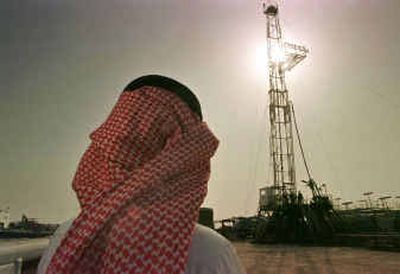Oil prices hit new high

LONDON — Oil prices surged near $42 a barrel Monday as markets shrugged off a Saudi proposal that OPEC raise its official output target by 6 percent.
Separately, the Energy Department said the average U.S. retail price of a gallon of gasoline passed $2 for the first time.
Analysts argued that the Organization of Petroleum Exporting Countries must do more — by adding real barrels to world supplies — if it expects to curb the relentless rise in crude prices.
A senior OPEC delegate, speaking on condition of anonymity, said the group was so worried about overheated prices that it might consider making a larger increase in its target than Saudi Arabia initially suggested last week.
OPEC, which supplies one-third of the world’s oil, plans emergency talks this weekend in Amsterdam to discuss a possible target increase of 1.5 million barrels. Because OPEC already exceeds its current target by more than this amount, analysts say such a move would only legitimize some of OPEC’s overproduction and do nothing to trim prices.
“It’s not that it won’t be enough. It’s irrelevant,” said Leo Drollas, chief economist of the Center for Global Energy Studies in London.
Futures contracts of U.S. light crude for June delivery reached $41.85 a barrel in New York, before retreating to $41.55, up 17 cents from Friday’s close. It was a new record close on the New York Mercantile Exchange. In London, July contracts of North Sea Brent reached $38.50 a barrel on the International Petroleum Exchange, but were up just 4 cents by evening at $37.90.
June gasoline futures also reached a new high Monday in Nymex trading, closing 0.69 cent higher at $1.417 per gallon. In its weekly report of retail gasoline prices, issued Monday, the Energy Department said Americans paid an average price of $2.017 per gallon, up 7.6 cents from the previous week. That was the first time the national average topped $2, the agency said.
In other Nymex trading, June heating oil was essentially unchanged at $1.043 per gallon, while natural gas futures rose 2.3 cents to $6.424 per 1,000 cubic feet.
Pressure is building on OPEC to dip into some of its spare production capacity to boost actual output — not just its target. Markets are stretched by unexpectedly strong demand and spooked by turmoil in Iraq and uncertainty elsewhere in the oil-rich Middle East.
The assassination Monday of the head of the Iraqi Governing Council underscored the political instability in that country, which has the second-largest proven crude reserves after Saudi Arabia. Izzadine Saleem was the second and highest-ranking member of Iraq’s U.S.-appointed council to be assassinated.
The senior OPEC delegate said representatives at the group’s upcoming meeting might discuss raising their target by more than 6 percent.
“There’s no fixed position in terms of numbers,” the delegate said.
Most OPEC members are cashing in on current high prices by pumping an estimated 2 million barrels above their target of 23.5 million barrels. However, if prices stay high, they could damage economic growth and weaken demand for crude. High prices also encourage non-OPEC producers such as Russia and Mexico to pump more oil of their own, worsening the risk that prices may collapse due to oversupply.
“We are very worried and very concerned about the situation in the oil market, and we know we will do what we have to bring back stability,” the OPEC delegate said.
In spite of OPEC’s efforts to micromanage oil supplies, the current robust demand for crude has caught it by surprise. Any decision to increase its production target would mark a major policy reversal. OPEC only just decided at the end of March to reduce its target by 4 percent to 23.5 million barrels.
The group had feared that seasonal demand would fall during the spring quarter, and it acted preemptively to prevent an oversupply of crude. But instead of falling, demand for oil and refined products intensified in the United States, Europe and China.
Bottlenecks at U.S. refineries, heavy speculative investment in oil futures and concerns about security in the Middle East — including Saudi Arabia, OPEC’s most powerful member — added fuel to soaring prices. The price for a barrel of OPEC’s benchmark blend of crudes has risen to $37.67, or 51 percent more than the official targeted price of $25.
Regardless of what OPEC decides to do with its production target, it should boost actual output by around 500,000 barrels, said Adam Sieminski, an oil price strategist at Deutsche Bank in London.
“That certainly won’t be enough to crash prices, but it might take the upside away,” he said.
Drollas estimates that the 10 OPEC members bound by output quotas have a combined 3.2 million barrels in spare production capacity.